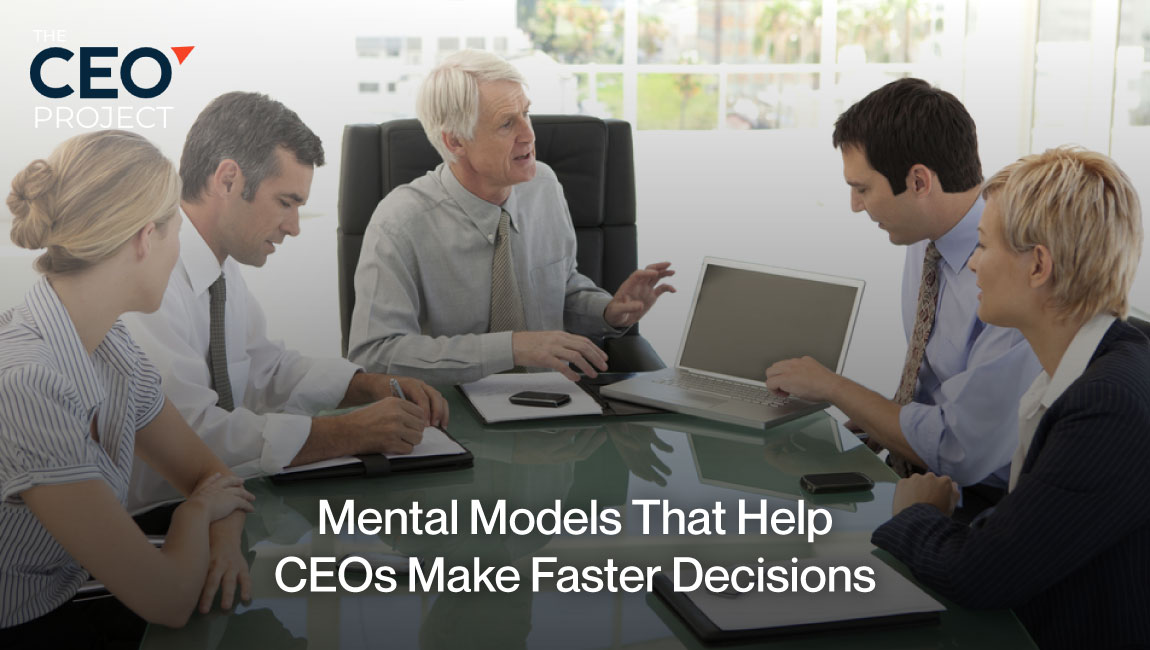As business demands continue to accelerate, it’s more crucial than ever for CEOs to make rapid decisions under pressure, while maintaining clear, focused judgment. According to McKinsey & Company, companies with agile decision-making processes are 70% more likely to be in the top quartile of financial performance. However, the urgency to act promptly can cause decision fatigue and mistakes.
Here is where mental models can be helpful. These cognitive models support leaders in processing information more effectively, helping them resolve complexity and make decisions quickly.
In this post, we are going to discuss:
- Why both speed and clarity matter in executive decision-making
- What mental models and why do CEOs need them
- How to create a decision framework with these models
Let’s dive in.
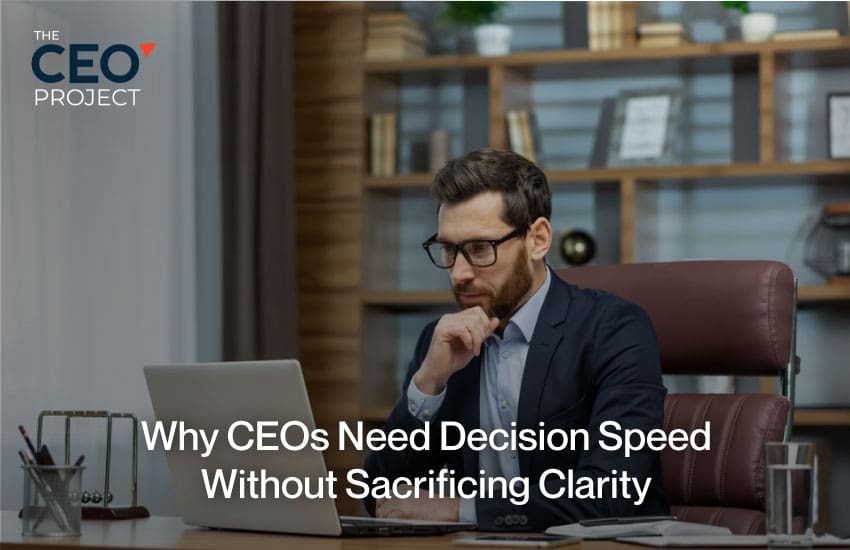
Why CEOs Need Decision Speed Without Sacrificing Clarity
CEOs usually operate at the points of inflection, where delay can mean missed opportunities or create a bigger crisis for themselves. Making quick decisions isn’t just an asset—it’s a necessity. But speed at the expense of clarity is inexcusable. Quick decisions without a clear understanding can lead to expensive mistakes.
Mental models are tools for solving this equation. They are organized mechanisms for dealing with complex problems, enabling CEOs to make quick and well-informed decisions.
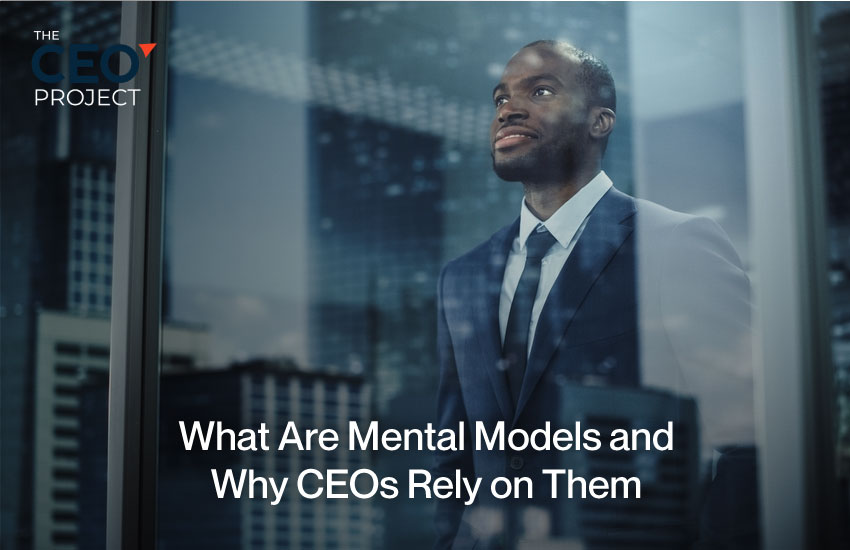
What Are Mental Models and Why CEOs Rely on Them
CEOs often have to deal with complicated and dynamic circumstances in a high-pressure business environment. New problems continue to arise, unseen barriers get in the way, and countless other factors constantly impact potential outcomes, so it can feel overwhelming to make decisions and act with confidence. That is where mental models come in.
These cognitive models serve as guides, allowing CEOs to simplify, categorize, and understand complex situations. Leaders use mental models to systematically approach problems, evaluate risks sensibly, and make the best decisions.
In an era of unprecedented complexity, mental models are critical for CEOs’ attempts to stay one step ahead and lead confidently.
What Are Mental Models?
Mental models are mental shortcuts—cognitive frameworks—that help us discover, understand, or make decisions about the world. They offer a framework for organizing complicated problems.
For CEOs, mental models are repeatable and flexible tools that lead to faster, more intelligent decision-making without getting bogged down by noise and distractions. Mental models help us simplify complexity so that we can derive clearer and more actionable insights.
Why Do CEOs Rely on Mental Models?
Mental models are more than just a luxury to CEOs; they are a fundamental part of their decision-making process. These models bring a systematic approach to problem-solving, allowing us to address complexity by making it more understandable and providing a clear path to follow.
Here are a few of the most important reasons why CEOs become so dependent on mental models:
- Simplify Complexity
- Enhance Decision-Making
- Improve Communication
- Anticipate Outcomes
- Promote Consistency
1. Simplify Complexity
In business, complexity is the norm. CEOs have to make decisions in various dimensions, such as strategy, finance, marketing, operations, and human resources. Mental models help CEOs simplify these complex problems into more manageable pieces. By simplifying the complexity, CEOs can concentrate on what matters and make better-informed choices.
- Example: The 80/20 Rule (Pareto Principle)—This model states that 80 percent of the results are produced by 20 percent of the efforts. By pinpointing the most impactful tasks, CEOs can spend resources more wisely and concentrate their focus on what leads to the best results. This also minimizes decision fatigue and focuses attention on projects that have the highest returns.
2. Enhance Decision-Making
While speed is vital to being a successful leader, making an informed and strategic decision is also important. Mental models help manage the decision-making process by enabling established criteria for evaluating options. This allows CEOs to make thoughtful decisions, even under extenuating circumstances.
- Example: Second-Order Thinking—This approach enables CEOs to think not just by focusing on first-degree outcomes of their decisions but also by considering long-term effects. With second-order thinking, CEOs can foresee the challenges that lie ahead and make decisions that are aligned with their company’s strategic vision, leading to its long-term success.
3. Improve Communication
Communication is the key to Successful Leadership. By having a shared language among CEOs and their teams, mental models help to maintain alignment and clarity around decision-making and strategy. The models make explaining and executing complex strategies easier and ensure everyone is on the same page in the organization.
- Example: The Eisenhower Matrix encourages CEOs to classify tasks based on their urgency and importance, which in turn makes the process of delegating responsibility simpler. This also helps streamline the process by prioritizing activities, leveling the expectations with teams, and clearly communicating when the work should be delivered, avoiding any confusion and maintaining business productivity.
4. Anticipate Outcomes
Good CEOs are not just proactive; they are anticipatory. Mental models enable CEOs to anticipate the consequences of their decisions and assess risk and reward. This forward-thinking approach is anticipatory, prevents potential mishaps down the road, and allows them to make decisions that generate great results.
- Example: Bayesian Probability—This model focuses on updating decisions considering new data. If conditions change, CEOs can then alter strategies accordingly based on new probabilities. This ability to forecast the future and adjust as events unfold on the ground makes CEOs strategically superior.
5. Promote Consistency
Maintaining consistency in decision-making is particularly important to ensure alignment with organizational goals and values. Mental models offer a systematic approach to decision-making that allows for rational and logical thought rather than emotional impulses. This results in more predictable outcomes and builds trust inside the company.
- Example: First Principles Thinking—By breaking down assumptions and focusing on the core truth of a problem, CEOs can craft logic-based decisions. This model highlights the importance of consistency in decision-making, ensuring that each decision is based on clear-cut and well-known principles.
How Mental Models Improve CEO Effectiveness
With the aid of these mental models, CEOs can navigate the challenges they encounter more efficiently, thus making more informed and timely decisions. Such frameworks bring order and simplicity to complex decision-making processes, allowing CEOs to think critically and analyze the downside risk when facing critical strategic decisions that will determine an organization’s success.
Real-World Example: Elon Musk, an early proponent of First-Principles Thinking, has applied this model to redefine sectors such as electric cars and space travel. By removing all these assumptions and starting from first principles, Musk has devised creative solutions that have revolutionized entire industries.
Likewise, the Inversion model is an incentive for CEOs to spend extra time contemplating risks and preventing mistakes by focusing on what might go wrong. It encourages decisions with a clear understanding of the downside to avoid, reducing the downsides , and encouraging CEOs to make decisions with long-term sustainability in mind.
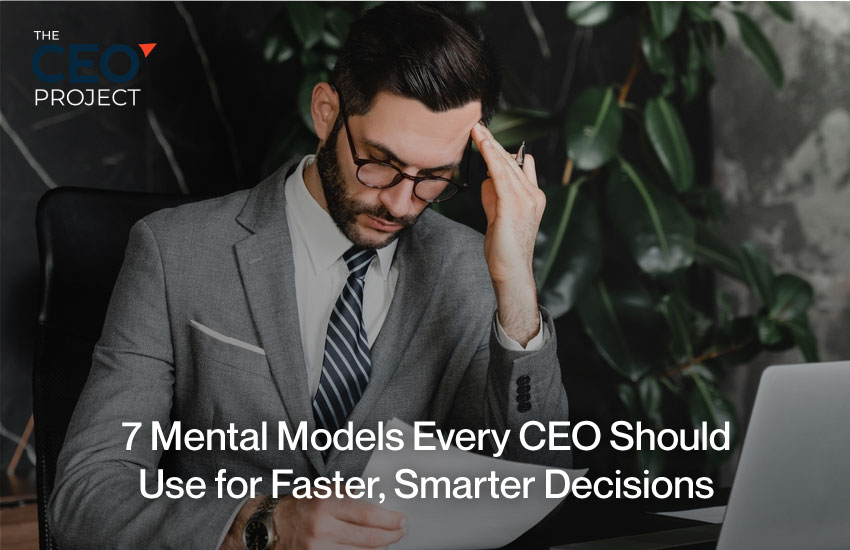
7 Mental Models Every CEO Should Use for Faster, Smarter Decisions
As a CEO, the pressure to make rapid, high-stakes choices never ends. McKinsey’s research reveals that executives in top-performing companies make decisions 2.5 times faster than their opponents, which benefits their innovation and ability to stay ahead of the competition.
While speed matters, it should not be achieved at the expense of clarity or quality. So, how can CEOs make faster, better decisions without ignoring important information?
The trick is to employ mental models — time-tested frameworks that help avoid getting lost in irrelevant aspects and promote focusing on factors that matter for growth and success. Below, we’ll address seven powerful CEO mental models used to make decisions quickly and accurately.
Excited to tackle your toughest challenges and achieve success?
- First Principles Thinking
- Inversion
- Eisenhower Matrix
- OODA Loop (Observe–Orient–Decide–Act)
- Second-Order Thinking
- 80/20 Principle (Pareto Principle)
- Mental Model Stacking
1. First Principles Thinking
- What It Is: Analyzing hard problems down to their primitive building blocks and reasoning from there.
- Example: Elon Musk employed first principles thinking to disrupt the aerospace industry with SpaceX by re-evaluating the cost models behind building rockets. (5 Mental Models Top Decision-Makers Swear By – Mind Lab Pro)
2. Inversion
- What It Is: Problem-solving is done by considering the opposite of your goal.
- Why It’s Useful: It lets you identify and avoid possible traps.
- Example: Rather than questioning “How do we improve customer satisfaction?” inquire, “How can we increase customer dissatisfaction?” and then avoid those actions.
3. Eisenhower Matrix
- What It Is: A time management system categorizes tasks by urgency and importance.
- Why It’s Useful: It helps you prioritize your tasks and focus on what is truly important.
- Example: A chief executive officer or CEO utilizes the matrix to offload non-critical tasks, giving more time for strategic planning.
4. OODA Loop (Observe–Orient–Decide–Act)
- What It Is: A decision-making framework created by military strategist John Boyd.
- Why It’s Useful: Encourages agility and swift responsiveness in changing environments.
- Example: During a crisis, a CEO notices market changes, orients by seeking data, decides on a path forward, and acts decisively to mitigate risks.
5. Second-Order Thinking
- What It Is: Looking ahead to the effect of decisions over the long term.
- Why It’s Useful: Avoiding unintended consequences by understanding the ripple effects of your actions.
- Example: A CEO contemplates the impact on morale and productivity down the line before implementing a cost-cutting measure. (16 Mental Models for Founders and Leaders | Personal Growth)
6. 80/20 Principle (Pareto Principle)
- What It Is: 80% of results come from 20% of efforts.
- Why It’s Useful: Facilitates determining and concentrating on the most impactful activities.
- Example: A CEO realizes that 20% of products account for 80% of revenue and reallocates resources accordingly.
7. Mental Model Stacking
- What It Is: Using multiple mental models to analyze the problems from different perspectives.
- Why It’s Useful: Results in a deeper understanding and better problem solutions.
- Example: A CEO combines first-principles thinking, second-order thinking, and the 80/20 principle to develop a new business strategy.
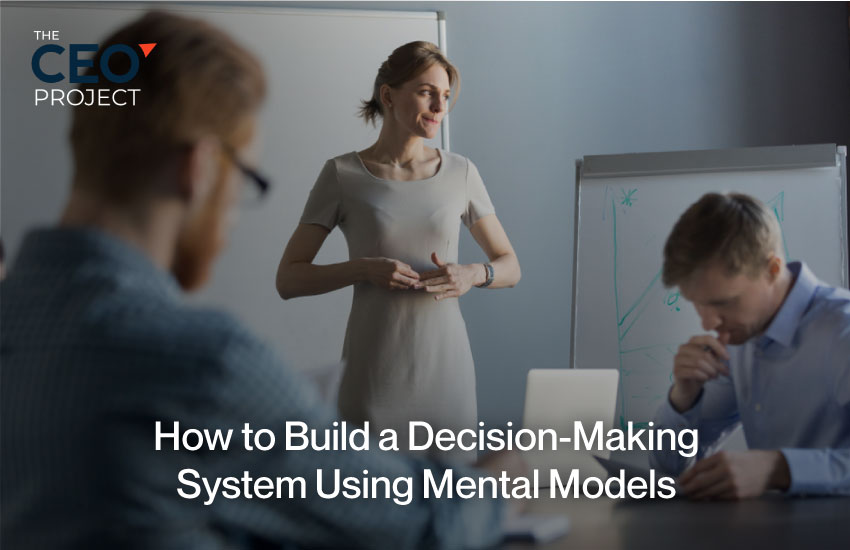
How to Build a Decision-Making System Using Mental Models
Mental models can be used to improve decision-making by applying them to operational activity.
Strategies for Implementation:
- Use Reflection Prompts: Encourage leaders to ask questions corresponding to mental models in decision-making.
- Incorporate into 1:1s and Leadership Discussions: Talk about mental models in the routine meetings to encourage the application.
- Create a Decision Journal: Write down decisions and the models behind them, along with their results so that you can learn from experience.
- Develop Training Programs: Train teams on different mental models and how to use them in their work.
- Encourage Cross-Functional Collaboration: Different worldviews can broaden the approach to mental models.
Want to Manage Time Like a High-Performing CEO?
A CEO’s most valuable resource is time. Find out how the world’s most successful CEOs maximize productivity and success. Read our newest blog, “How High-Performing CEOs Manage Their Time Effectively,” and learn how to take charge of your time.
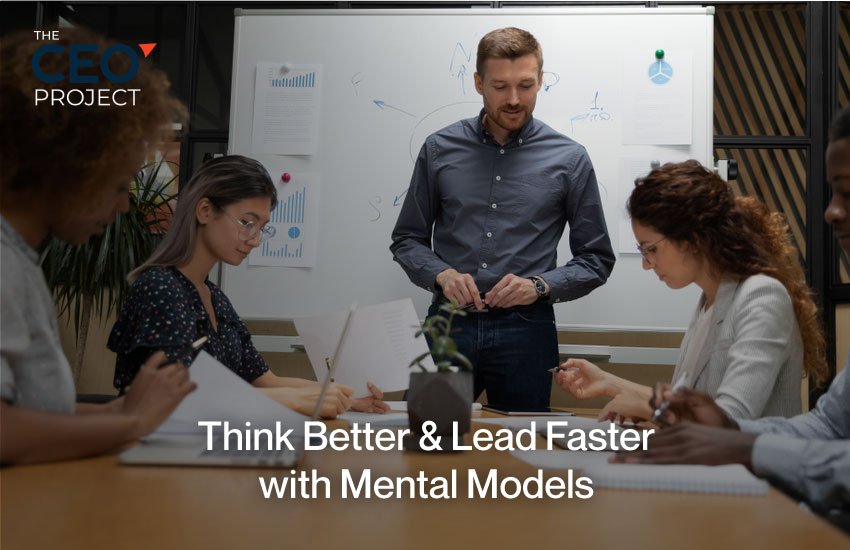
Think Better & Lead Faster with Mental Models
Mental models in your decision-making will help you think faster, make better decisions, and lead with more confidence.
How to make the most of them:
- Leverage Mental Models to Make Decisions in Real Time
- Build a Mental Model Toolkit
- Teach Your Team to Think with Mental Models
- Create Post-Mortems and Learn from Past Decisions
1. Leverage Mental Models to Make Decisions in Real Time
One of the hardest tasks for a CEO is making decisions quickly in the absence of complete factual details. By employing mental models, you can simplify complicated things and apply them to decision-making.
For example:
- First Principles Thinking can help you cut through your assumptions and find the core of the issue.
- The OODA Loop allows you to observe and adapt to market changes quickly
- The 80/20 Rule makes sure you concentrate on the most important tasks and avoid distractions.
If CEOs apply these models in real-time, they can cut down their decision-making time and act quickly.
2. Build a Mental Model Toolkit
Having a set of tools that are easily accessible is one factor that makes you a great decision-maker. One way to make sure you’re ready to act in any situation is to create a “mental model toolkit.” To build your toolkit:
- Begin by selecting the most helpful models that suit your role (i.e., the Eisenhower Matrix when prioritizing tasks or Inversion to avoid falling into the traps).
- Frequently review and get yourself used to these models. Practice will help you use them when necessary.
- Ask yourself: What mental models can I use to make this decision-making process easier?
3. Teach Your Team to Think with Mental Models
You don’t have to be the one person making all the decisions as a CEO. Enabling your team to leverage mental models will help them make better decisions faster and more confidently. For example:
- Train your leadership team in critical decision-making models like Second-Order Thinking and the Pareto Principle.
- Urge them to use these frameworks to tackle problems or decisions.
- Foster an environment where decisions are made systematically and based on solid theories, not merely by instinct.
This mental model training can help the organization become more agile and aligned, ready to solve problems quickly and effectively.
4. Create Post-Mortems and Learn from Past Decisions
A significant factor in becoming a better decision-maker is trying to learn from previous decisions you have made. You can improve over time by integrating a system to reflect and analyze. Here’s how:
- Have reflection prompts set in place to analyze the reason for the success or failure of a decision?
- Do post-mortems regularly, where you examine your key decisions, the models you used , and the results.
- With time, you will refine your use of mental models and become clearer about how you make decisions.
By learning from experience and trying out different ways of doing things, you will be able to make better decisions.
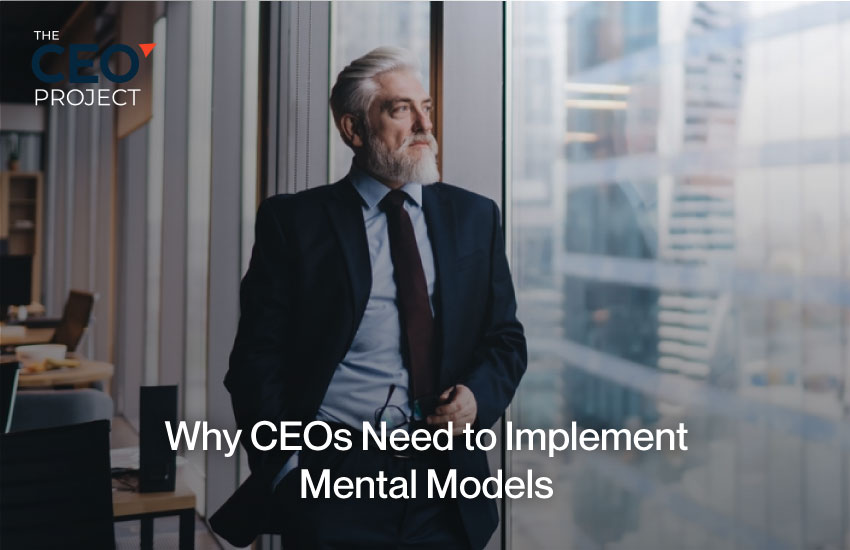
Why CEOs Need to Implement Mental Models
Quick decision-making is a necessity in today’s business environment; however, it must not come at the cost of clarity and strategy. With the help of mental models, CEOs can significantly enhance the pace and, most importantly, the quality of their decision-making.
Here’s how CEOs can apply mental models to their daily work:
- Prioritize critical models that have the most direct relevance to your leadership context.
- Develop a decision-making system that fuses different mental models to solve complex problems through different perspectives.
- Create a decision-making culture that reinforces the use of mental models throughout your team.
- Evaluations of decisions you make regularly help you to continue making improvements.
Finally, mental models do help simplify things, speed up decision-making, and, in general, make the leader more effective. These types of potent tools enable CEOs to increase the speed and quality of their decision-making, which in turn guarantees that their company remains competitive and able to adapt.
Ready to improve your leadership decision-making ? Begin by adding a few mental models to your daily activities. Try one model out today and see how it changes your decisions.
At The CEO Project, we offer support and coaching so you can grow and scale your business effectively! We help you create a framework for decision-making that enables you to make better, faster decisions.
Contact us today to learn more about our CEO Advisory Services and how we’ll accelerate your growth.
FAQs
What are the best mental models for decision-making?
Warren Buffett’s Two-List System, First Principles Thinking, and the Cynefin Framework are great mental models for making decisions. Leaders rely on these models to deconstruct complex problems, mitigate cognitive bias, evaluate risks, and respond to shifting environments, thereby allowing them to make smarter decisions more quickly across a wide range of environments.
Which should a CEO focus his time on most?
CEOs should focus on strategic planning, developing the next generation of leaders, and nurturing innovation. By concentrating on these areas, CEOs will place their organization on a path to empower their workforce. It also aligns their efforts with their long-term vision to develop a solid leadership pipeline. This, in turn, will drive ongoing innovation, setting the stage for sustainable growth and adjusting to what the future may throw at them.
Why is decision speed so critical for a CEO, specifically?
The speed of decision is really important for CEOs. It directly impacts the company’s capacity to respond and be relevant. The ability to make fast decisions helps CEOs react in a timely manner to market changes, operational issues, and consumer requests. It will enable the company to stay nimble and ahead of the competition in fast-moving markets.
How do I know which model to apply to which type of decision?
The selection of a decision-making model is contingent on the issue’s complexity. For straightforward, well-defined problems, models such as First Principles Thinking are applied to decompose them. Tools such as Cynefin provide a systematic means for managing ambiguity and making educated decisions for more complicated or ambiguous issues.

